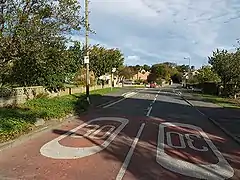| Easington | |
|---|---|
 Easington village | |
.svg.png.webp) Easington Location within North Yorkshire | |
| Population | 923 (2011 census)[1] |
| OS grid reference | NZ744181 |
| • London | 210 mi (340 km) S |
| Civil parish | |
| Unitary authority | |
| Ceremonial county | |
| Region | |
| Country | England |
| Sovereign state | United Kingdom |
| Post town | SALTBURN-BY-THE-SEA |
| Postcode district | TS13 |
| Dialling code | 01287 |
| Police | Cleveland |
| Fire | Cleveland |
| Ambulance | North East |
| UK Parliament | |
Easington is a village in the civil parish of Loftus, in the Redcar and Cleveland district, in the ceremonial county of North Yorkshire, England and is part of the North York Moors National Park.[2] The village is situated on the A174 road, 1 mile (1.6 km) east of Loftus, 8 miles (13 km) east of Guisborough, and 10 miles (16 km) north-west of Whitby.[3] At the 2011 census, the village had a population of 923.[1]
History
The village is mentioned in the Domesday Book as belonging to Earl Hugh of Chester and having 34 ploughlands.[4] The village name derives from the Old English Esa-ingtūn; literally the farm or settlement of Esa's people.[5] Historically, the name has been spelled as Esingeton and Esington.[6]
Historically part of the North Riding of Yorkshire, the village was transferred to the new county of Cleveland in 1974. Cleveland was returned to North Yorkshire in 1996. The village is in the unitary authority of Redcar and Cleveland.[7][8][9] Originally, the estate of Easington and Boulby had its manorhouse at the eastern end of the village.[10] In 1799, a new estate was purchased to the south, and a new manorhouse, in what is now Grinkle Park, was built in 1802.[11] The old manorhouse had a moat built somewhere between 1250 and 1350. The site is now part of a working farm, but it remains a scheduled ancient monument.[12] In 1951 the civil parish had a population of 411.[13] On 1 April 1974 the parish was abolished and merged with Loftus.[14]
All Saints Church, a Grade II listed building, was built in 1888–89 by C. Hodgson Fowler in Decorated style, largely with bequests from the Palmer family of Grinkle Park, and incorporated fragments and remains of the previous church.[15][16][10] The side chapel and several of the furnishings are by 'Mousey' Thompson of Kilburn.
The public house, the Tiger Inn, was previously a building of the same name at the opposite end of the village.[17][18]
A railway station on the Whitby, Redcar, and Middlesbrough Union Railway opened in 1883 as Easington. Its name was changed to Grinkle after the local house and seat of the Palmer Baronets of Grinkle Park in 1904. The renaming avoided confusion with the station at Easington, County Durham, also on the North Eastern Railway. The station closed on the eve of the Second World War and never reopened although the line remains a freight-only railway to Boulby Mine.[19]
The village will be on the route that cyclists will race through on the 1st stage of the 2020 Tour de Yorkshire. The stage will start in Beverley, making its way up the Yorkshire Coast before finishing in Redcar.[20]
Palmer Baronets
The Palmer Baronets, of Grinkle Park in the County of York and of Newcastle upon Tyne, were created in the Baronetage of the United Kingdom on 31 July 1886 for Charles Palmer, a coal and shipping magnate and Liberal politician.[10]
References
- 1 2 UK Census (2011). "Local Area Report – Easington (Redcar and Cleveland) Built-up area (E34000923)". Nomis. Office for National Statistics. Retrieved 2 February 2020.
- ↑ "OL27" (Map). North York Moors - Eastern Area. 1:25,000. Explorer. Ordnance Survey. 2016. ISBN 9780319242667.
- ↑ "Genuki: Easington, Yorkshire (North Riding)". www.genuki.org.uk. Retrieved 2 February 2020.
- ↑ "Easington | Domesday Book". opendomesday.org. Retrieved 2 February 2020.
- ↑ Mills, A. D. (2003). A dictionary of British place-names. Oxford: Oxford University Press. p. 169. ISBN 0-19-852758-6.
- ↑ Ekwall, Eilert (1947). The concise Oxford dictionary of English place-names (3 ed.). Oxford: Clarendon Press. p. 149. OCLC 12542596.
- ↑ "Yorkshire - Main Page genealogy project". geni_family_tree. Retrieved 2 February 2020.
- ↑ "Sense of Yorkshire identity that defies the boundaries on a bureaucrat's map". The Yorkshire Post. 24 December 2011. Retrieved 2 February 2020.
- ↑ "Registration Districts in North Yorkshire". www.ukbmd.org.uk. Retrieved 2 February 2020.
- 1 2 3 "'Parishes: Easington', A History of the County of York North Riding: Volume 2 (1923), pp. 340–343". British History Online. Retrieved 18 March 2012.
- ↑ Wickham, Louise (March 2018). "NYMNPA Historic Designed Landscapes Project Grinkle Park" (PDF). yorkshiregardenstrust.org.uk. p. 4. Retrieved 2 February 2020.
- ↑ Historic England. "Moated manor and medieval settlement, Easington (1012307)". National Heritage List for England. Retrieved 2 February 2020.
- ↑ "Population statistics Easington AP/CP through time". A Vision of Britain through Time. Retrieved 1 December 2023.
- ↑ "Cleveland Registration District". UKBMD. Retrieved 1 December 2023.
- ↑ Historic England. "Church of All Saints, Loftus (Grade II) (1139699)". National Heritage List for England. Retrieved 25 October 2014.
- ↑ "All Saints, Easington". Achurchnearyou.com. The Church of England. Retrieved 25 October 2014.
- ↑ "Explore georeferenced maps - Map images - National Library of Scotland". maps.nls.uk. Retrieved 2 February 2020.
- ↑ "Easington and Loftus Alum Quarries: Walk with Bob Woodhouse". Gazette Live. 14 March 2014. Retrieved 2 February 2020.
- ↑ "Disused Stations: Grinkle Station". www.disused-stations.org.uk. Retrieved 25 September 2017.
- ↑ Robson, Dave (17 January 2020). "Tour De Yorkshire 2020: Date and route revealed for when race comes to Redcar - Saltburn, Easington, Loftus and Carlin How will all feature on the race route, organisers have revealed". infoweb.newsbank.com. Retrieved 2 February 2020.
External links
 Media related to Easington, North Yorkshire at Wikimedia Commons
Media related to Easington, North Yorkshire at Wikimedia Commons